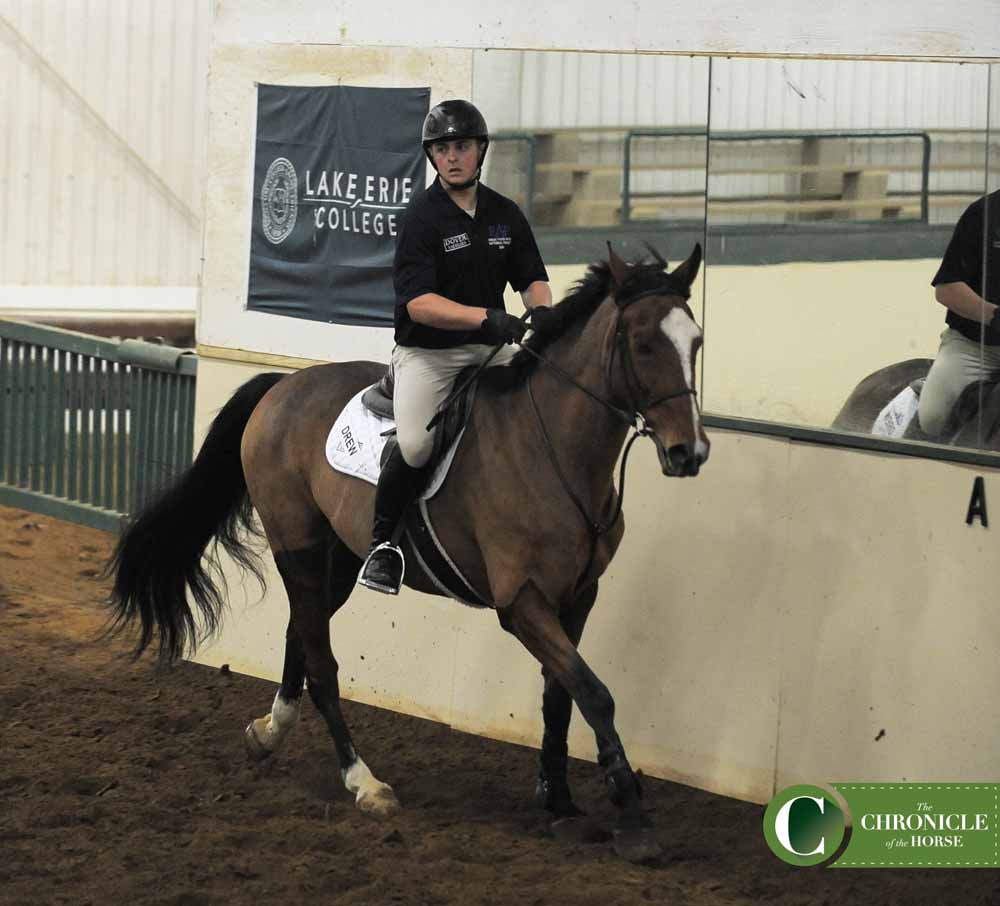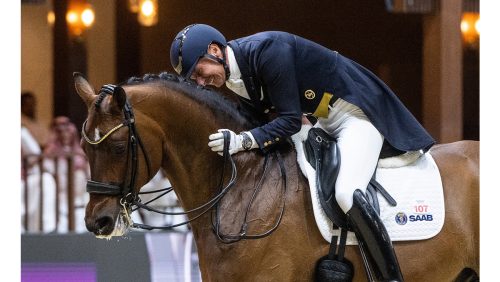Mentor, Ohio—Nov. 12
“We’re all talking that today might be our best second day of all the clinics that we’ve done,” said lead clinician Peter Wylde after the last of the four teams rolled up their stirrups. “Of all eight years, this might have been the best second day where the horses and the riders were really awesome. They did great exercises. Great work. Good riding. The horses went well. We had very few problems. It was impressive so I was excited about that.”
After learning yesterday the ways of their horses and absorbing all of Wylde’s words of wisdom, the 16 members of the 2016 USHJA Emerging Athletes Program National Training Session returned with more sophistication.
“Part of yesterday and today is all about getting the horses and the riders together and having them be able to develop that communication,” said Wylde. “In a very short amount of time, they got to connect with the horse, understand the horse and have the horse accept them as their rider. And so I was really excited to see today, in all the horses across the board, the flatwork was better. They were softer, rounder.”
Continuing on the softness theme of yesterday, Wylde introduced more courses and lines for the riders in order to prepare them for the Nations Cup style competition tomorrow.
Wylde asked for transitions on the flat, from trot to walk, and canter to sitting trot.
“Those transitions are super important with developing the connections so that you are solid together,” he said. “You can educate your horse to be very balanced and soft through those transitions.”
“All this flatwork trains the horse to be really ready to your aids, so you can really do whatever you want to do,” he continued.
And throughout the sessions, he stressed the importance and relationship between flatting and jumping.
ADVERTISEMENT
He asked the riders to set up for jumping on the flat, by opening up the horses stride on the long side and then shortening through the corners.
“Practice moving up to a jump and practice settling after a jump,” he said. “Test your gas and brake petals.”
And when each session started jumping both directions over a simple crossrail, Wylde showed that there shouldn’t be a change in flatting and jumping.
“The canter you have now is different from the canter you held on the flat,” Wylde said to Caroline Dance when she changed pace over the crossrail with her horse “Red.” “Try to get the same canter. Pretend that you are doing a circle at the canter and the jump is just in your way.”

Drew Arnold practiced getting the correct canter on Oz. Photo by Laura Lemon
After warming up more on the right lead with a vertical and the left lead with an oxer, it was time for the riders to catch the rhythm and stride length of their mounts. Wylde started with the riders working with a four-stride outside line, after which they needed to ask for a walk at a flower-box-designated spot. He then introduced new elements like a bending six-stride line and then a two-to-five-stride combination. After moving the combination so that the two strides was more forward and the five strides was shorter, Wylde presented the riders with their final course before tomorrow.
Riders were asked to start over their four-stride outside line, walk at the flower box, pick up the canter again and do the bending six strides across the diagonal, execute the long two-stride to short five-stride line on the outside, trot the crossrail before finishing off down a four-stride diagonal line.
Throughout the sessions, Wylde commented on stretching the rider’s upper body back away from the horse’s head.
“It never worked for anybody to get out over their hands,” he said to Cecily Hayes.
ADVERTISEMENT
“I would love you to sink into your seat around the turn,” he continued, this time commenting to Amanda Lamore. “Connect your seat to put our horse in front of you instead of you leaning in front of your horse.”
This simple position fix, Wylde insisted, opens up more distance options for the riders and brings a higher level of sophistication and skill to the rider’s ability.

Bridie Hamilton worked on not letting her upper body lean too far toward the neck. Photo by Laura Lemon
“If you’re trying to take the first distance because the lines are so long, it will get you in trouble as you move up the levels,” he said. “I like to train that you have options. You need to be able to do both. You need to be able to jump that in a seven [strides] if you need to.
“We’re sort of taught as kids to sort of stay in this half seat, two-point—but as you start to jump higher, [and as] you watch the better riders in the world, the balance starts to go back a little bit,” he continued after the training sessions. “[If] the balance is in front of you, the distance is so much clearer than if you get out over your hand and everything is sort of into the ground. Nine times out of the ten, the distance is not there or you don’t see it. So we worked a little bit on that, sort of raising your eye level and frame. Not necessarily the horse’s frame, but just the balance [so] that it’s not so much on the forehand. And then it makes it a lot easier to ride the course. If you need to wait out of the turn, the horse can be much more polite out of the turn.”
And after the end of the first session, Wylde imparted more wise words.
“Out there, great training is watching the greats do what they do,” as he said he did in Europe watching Ludger Beerbaum continue to flat his horses after completing a round. “Whenever you have a free moment, instead of Facebook, watch.”
In addition to riding their horses one final time with Wylde, the finalists also met with sports psychologist Kip Rosenthal and learned more from Anne Thornbury about stable management. In addition, Wylde demonstrated his commitment to the Emerging Athletes Program by donating his clinician’s fee to the USHJA Foundation.
Read more about Day 1 of the USHJA EAP National Training Sessions and make sure to check back tomorrow for a report on the final day Nations Cup competition at www.coth.com.














